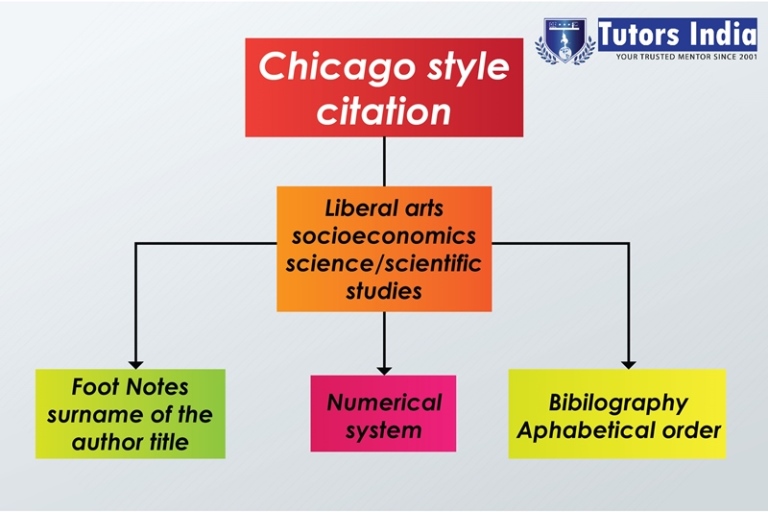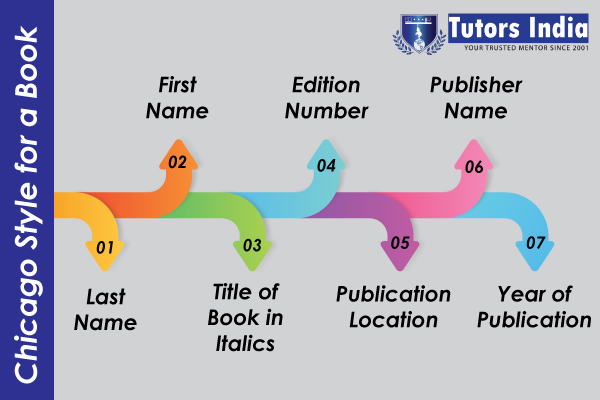Chicago Style Citation Help
The Chicago citation style is a system for recording sources used in a scholarly article that was developed by the University of Chicago Press. In the liberal arts, socioeconomic sciences, and scientific studies, the Chicago citation style is commonly employed for academic writing. Within the Chicago style, there are two referencing formats. One is a bibliography of notes, while the other is an author's date.
You must credit the sources utilized in your work all through content of your dissertation. You must cite your sources whenever you give a statement of proof, such as a quotation, or when you employ someone else's thoughts, views, or hypotheses in your own wording (paraphrasing).
The Chicago notes-bibliography style is a numerical system that acknowledges authors by assigning a number to each reference. This in-text number can be followed to the matching number in the endnote or the footnote. To the right of full stops and commas, and to the left of semi-colons and colons, place citation numbers in superscript.
The footnote reference information can be relatively brief in most project papers and articles that contain footnotes and a bibliography because the complete facts can be accessed in the bibliography. In a big text with non-citation linked annotations, endnotes (or both footnotes and endnotes) may be utilized.
You must mention the writer of the article or those responsible for the work when summarizing the general understanding of a source in your own words. Each reference gets a new number, even if it was already cited. Place the number at the end of the phrase or clause every time you want to cite sources.
Example
…and Mark defined the tale thoroughly1
The description of mechanism can be separated into the two types2, however others propose...
If a quote is less than 100 words or eight lines long, use double quote marks to encapsulate this within the text.
Example:
Mark explained that tenor should be “anti-solemn”3
If the statement is longer than 100 words or eight lines, this should be indented and shown without quote marks. Poetry, letters, and groupings of brief statements are all examples of quotes that could be balanced.
Footnotes: Because the Bibliography contains all of the information about a source, footnote references can be kept to a minimum. The surname of the author, title (shortened if longer than four words), and page, if provided, make up the shortened form. In a footnote, the page citation should come after the citation. To cite two or more sources in one footnote, use only one number in the text to denote them. Use a semi-colon to separate the citations in the footnote and arrange them in the order they occur in the text. Each footnote's first line should be indented 1.27cm from the left edge, or 5 spaces.
Bibliography: A detailed list of all the resources you mentioned in your paper, together with their full data. The bibliography in Chicago style begins on a separate page at the end of your project paper, labelled Bibliography. The Bibliography lists all of the materials you used to write your paper, including books you didn't cite in your paper but used in your investigation.
All resources in the Bibliography must be organized alphabetically by the first writer's surname, or by titles if no author is known. Titles of works by the same author/s are organized alphabetically. Single-author bibliographies are arranged sequentially. The first author's name is reversed (i.e., Margot Broadman becomes Broadman, Margot), while the names of succeeding authors are presented in the same order as they occur in the original article publication. Each element in the bibliography should indeed be spread with dangling indents. The first line of a dangling indent begins at the left hand column, and successive lines are indented 5 spaces or 1.27cm. Between citations, there are no line breaks. Each item in the bibliography should be always spaced with dangling indents. The first line of a dangling indent begins at the left margin, and succeeding lines are indented about 5 spaces (1.27cm). Between references, there are never line breaks.
The recommended format for book, periodical, and video titles is italics. Article and section titles, on the other hand, are not italicised; instead, they are enclosed in double quote marks. All key terms in the Chicago style must be capitalised with the first letter capitalised. The standard format for book, journal, and video labels is italics.

How to cite Chicago style for a book
When mentioning a book in Chicago style, the writer’s name, the topic of the book, the publication city, the publication name, and year of the publication are normally required. If more than one creator is listed, the first writer’s name is reversed, and a comma is put after the last name.
Example:
Last Name, First Name. Title of book in italics. Edition Number. Publication location: Publisher name, Year of publication. If you're quoting a specific section, include the section name and a period in quote marks before the title of the work, as well as the sentence "In." Have either the chapter number (together with a semicolon after the year of publication) or the comprehensive page numbers of the chapters (along with the text "Chap." before the "In" text before the book title).

Chicago reference style format
Bibliography is a detailed list of all of the sources that were used in the research work. The sources' significant publication details are included in the list. The following format must be followed in the bibliography:
- The bibliography or reference list must be single spaced.
- The writers' last names must be ordered alphabetically.
- The document's second line must be indented.
In general, Chicago citations require the following: Author, the title of the book or the article, its publication year, publication month and date, the name of the publisher and the city of publication.It also should include the date of access, page numbers, the name of Database or the URL.
Chicago style citation generator
It might be a great pain to write your first academic paper in Chicago format. It can be difficult to identify which Chicago style citations to use because the official handbook is so large. With a simple and understandable guide, you may sail through your dissertation by breaking down the Chicago and Turabian specific format and references into manageable chunks. To meet all of your citation demands, employ an easy-to-use Chicago style citation generator. Because the Chicago style is so different, you must know when you should utilise it for your research study. Take a look at your topic first. For writing about history, the arts, literature, and the social sciences, the Chicago style is ideal. It's also a good choice if you're undecided about which style to utilise because it's so adaptable.
Cited and bibliography formatting for MLA, APA and Chicago/Turabian citation styles
The MLA (Modern Language Association) is an organization dedicated to the arts and humanities. It aids in the deconstruction of quoting paintings, books, and other works of literature. The American Psychological Association (APA) is a professional organisation that publishes technical works in the social sciences. Citing journals and technical papers is a breeze with this format. The heading of the citations page is the most noticeable distinction between an MLA and an APA paper. A Works Cited page will be included in MLA papers. On the other side, the APA reference page will be labelled References. The reference will be double spaced and the both titles will be centred at the top of the page. The title makes it simple to figure out which one you're looking at. Turabian is usually mentioned when you learn about the Chicago format and style of writing as a student. Turabian is a style that is based on the Chicago Manual of Style. Turabian style, titled after Kate Turabian, breaks down research and writing advice into an easy-to-use style for both high school and college academics. Turabian is the way to go if you're a college student producing your first research paper in Chicago style.
While an outline isn't required, constructing one in the Chicago style is an excellent method to keep all of your ideas and references in one place. Keep the Chicago style format in mind when constructing your structure so that it flows naturally into your dissertation.
Accurate citation and bibliography help for APA, Chicago, Harvard and MLA
A citation is a technique of providing credit to persons for their creative and intellectual works that you utilised to support your research. It can also be used to track out specific sources and prevent plagiarism. A citation can typically include the author's name, date, publication company location, magazine title, or DOI (Digital Object Identifer). Academic disciplines prefer certain referencing styles because they work better with the types of texts that are most typically used in that discipline. The APA style of referencing is a variation of the Harvard style. Many of the traditions are the same, such as author-date citations in brackets in the text and full citations in the reference list. In APA style, a list of references rather than a bibliography is usually included. Website citations differ slightly in that they do not require an access or retrieving date unless the page is expected to evolve and change. Harvard style is also known as 'author-date' style. The writer's surname and the publication date, with the page number if it is a reference to a specific page, are used in the in-text citation in Harvard style, which can be in brackets in the body of the text or in footnotes. The bibliography or reference list is the sole place where you can find all of the details. It's critical to give credit to the original author when you borrow information from a source and use it in your study or project. This is accomplished by using an MLA citation. Citations may be included in the body of your project as well as in a works-cited list at the conclusion, depending on the type of material you're including.
Chicago style citation help
Researchers utilize the Chicago style to organise their written work and references. MLA and APA are two more common systems, and Chicago is only another style to add to the mix. MLA is commonly used in language and literature studies, APA are extensively used by science writers, and Chicago is frequently used by historians and other social scientists. Chicago is also used in a variety of different fields. Reach out to Tutors India for Chicago style citation help.
Chicago manual of style citation example paper
A title page is the first page of a Chicago paper. The paper's title should be about a third of the way down centered on the page .If there is a title and a description, both should have a subtitle be on various lines. A colon separates the two parts of the sentence. Your name should appear about two-thirds of the way down the page. Date and any other relevant information that is needed by your professor or usually the title and section of your class should be included.



